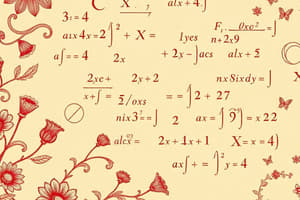Podcast
Questions and Answers
What is the standard form of a linear equation?
What is the standard form of a linear equation?
- y = mx + b
- x = a + by
- ax + by = c (correct)
- Ax + By = C
Which type of polynomial defines curvilinear phenomena like projectile motion?
Which type of polynomial defines curvilinear phenomena like projectile motion?
- Linear
- Quadratic (correct)
- Cubic
- Exponential
What method can be used to solve systems of equations by finding the point of intersection?
What method can be used to solve systems of equations by finding the point of intersection?
- Graphing (correct)
- Integration
- Elimination
- Substitution
Which formula is used to find the roots of a quadratic equation?
Which formula is used to find the roots of a quadratic equation?
What is at the heart of algebra?
What is at the heart of algebra?
In slope-intercept form, what does 'm' represent?
In slope-intercept form, what does 'm' represent?
Which of the following is an example of an expression?
Which of the following is an example of an expression?
What method in solving systems of equations involves eliminating one variable?
What method in solving systems of equations involves eliminating one variable?
What is an equation in mathematics?
What is an equation in mathematics?
In the equation 3y - 8 = 13, what is the goal when solving for y?
In the equation 3y - 8 = 13, what is the goal when solving for y?
Which type of equation contains only the first power of the variable?
Which type of equation contains only the first power of the variable?
What does x^2 represent in algebra?
What does x^2 represent in algebra?
Study Notes
Exploring Math's Foundational Branch: Algebra
Algebra is a fundamental branch of mathematics, built upon the principles of variables, expressions, equations, and relationships between quantities. Let's delve into this cornerstone subject and uncover its beauty and importance through some key concepts within algebra.
Variables & Expressions
At the heart of algebra lies the concept of a variable — a symbol representing an unknown quantity. For instance, we might represent the area of a square as (x) or the length of one side as (l). An expression is any combination of numbers, variables, and mathematical operations like addition, multiplication, division, or exponentiation. A simple example would be (7 + x^3 - 8), where (7) and (-8) are constants while (x^3) represents the cube of our unknown value ((x)).
Equations & Solving
An equation is a statement that two expressions have equal values when substituted with their respective values. Typically, there's one unknown variable (like (x)) you need to find the exact numerical value of by solving the equation using various methods such as substitution, elimination, or combining like terms. For example, if you know that (2x+9=15), your goal is to solve for (x), yielding (x = 3).
Linear Equations
Linear equations are a type of first-degree equation, which means each term contains only the first power of the variable. They can be expressed in slope-intercept form ((y = mx + b)), standard form ((ax + by = c)), or general form ((Ax + By = C)) depending on context and preference. Solving linear equations helps us understand directional movements over time (in the case of slope-intercept) or graphical representations (for other forms).
Quadratic Equations
Quadratics are second-degree polynomials containing terms raised to powers of up to 2. They take the shape of parabolas on a graph and define curvilinear phenomena like projectile motion and Newton's Law of Gravity. Solving quadratic equations requires more advanced techniques like completing the square or the quadratic formula, ultimately revealing the roots (or solutions) at specific points along the curve.
Systems of Equations
When more than one equation connects variables, we encounter systems of equations; these might arise in real life scenarios involving interdependence among factors. To solve them, try using the method of substitution, elimination, or graphing. Graphically speaking, the solution will lie wherever lines cross (if they do so once) or coincide (when parallel); alternatively, it may exist as infinitely many points (parallel cases without intersection).
In summary, algebra provides essential tools to interpret and manipulate data, analyze patterns, and solve problems across disciplines ranging from physics and engineering to social sciences. As you journey deeper into this captivating field, you'll discover countless applications and practical uses for this foundational discipline.
Studying That Suits You
Use AI to generate personalized quizzes and flashcards to suit your learning preferences.
Description
Test your knowledge on algebra's foundational concepts including variables, expressions, equations, linear equations, quadratic equations, and systems of equations. Explore key ideas in algebra and challenge your problem-solving skills with this quiz.




